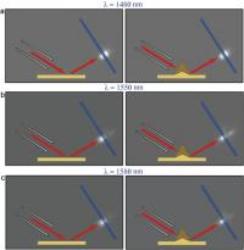Invisibility cloaks are apparently advanced devices and light can be bent and folded around nano-scale particles to render them invisible to the naked eye. But the light should be optimized to a magnitude greater than the object. This feature makes it difficult for the technique to be adopted in the optoelectronics segment, which calls for a nano-sized and fragile cloaking solution.
 Measured output range from flat surface and a cloaked protruded surface
Measured output range from flat surface and a cloaked protruded surface
A team of researchers from across the globe at the Technical University of Denmark (DTU), the University of Birmingham, UK, and Imperial College London, have used a technology termed, ‘carpet cloaks,’ that hides more than has been possible so far. The teams have used metamaterials, synthetic materials designed to display unnatural optical features.
Jingjing Zhang, a postdoctoral student at DTU's Fotonik Department of Photonics Engineering and Structured Electromagnetic Materials, says the carpet cloak has been designed on the lines of an alternating-layer formation on a silicon-on-insulator (SOI) platform, a technique that provides flexibility in addressing the size constraints. The cloak is made from metamaterials, and has been designed with a grating formation. A grating structure is actually a series of openings that help direct light of a specific wavelength around a nano-sized object.
Semiconductor production methods were used to create the anisotropic material patterned atop a silicon wafer layer with nanogratings of a matching filling. The resulting cloak is just a tiny bit bigger than the object. The filling factor indicates the grating size and forms the basis for the light wavelength that are affected by the cloak, which can be restored from the surface, to make it appear flat instead of a triangular bump, thus concealing it across wavelengths from 1480 to 1580nm. The cloak is fabricated from dielectric materials that are transparent to infrared light to enable the cloak to absorb a fraction of energy.
Jingjing Zhang, has co-authored the research paper titled, ‘Homogenous optical cloak constructed with uniform layered structures’, published in the Optical Society's online journal Optics Express.